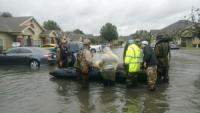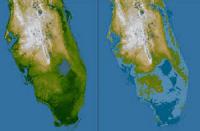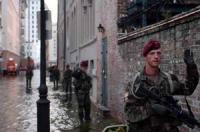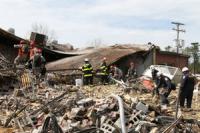-
Is Texas leading on disaster preparedness? Yes and no, experts say

During the first legislative session since Hurricane Harvey, state lawmakers are poised to make an investment in storm recovery and flood mitigation that some have described as unprecedented. But it’s more complicated than that.
-
-
Why the Great Plains has such epic weather
From 78 degrees on Tuesday to snow on Wednesday? Swings like this aren’t unusual in the central United States, where weather can quickly shift from one extreme to another. What generates such “big weather” on the Great Plains?
-
-
Preparing San Francisco for future storms
The San Francisco Bay Area has been pummeled this winter by storms packed with moisture from atmospheric rivers. San Francisco is partnering with the Berkeley Lab to assess how climate change may influence the intensity of atmospheric rivers and associated precipitation, and how those changes may impact San Francisco and its infrastructure.
-
-
Stern warning: Climate expert emphasizes the fierce urgency of now

Prominent economist and policymaker Lord Nicholas Stern delivered a strong warning about the dangers of climate change in a talk at MIT on Tuesday, calling the near future “defining” and urging a rapid overhaul of the economy to reach net zero carbon emissions. “The next 20 years will be absolutely defining,” Stern told the audience, saying they “will shape what kind of future people your age will have.”
-
-
Predicting, understanding urban flooding

Flooding is the natural hazard with the greatest economic and social impact on the population of the United States. Urban flooding is a complex and distinct kind of flooding, compounded by land use and high population density, and it requires a different approach to assess and manage.
-
-
Owners of unprotected coastal homes don’t rush to retrofit

Many coastal homes have significant structural vulnerabilities that leave homeowners and their homes largely unprotected from storms. Additionally, the majority of coastal homeowners have little to no intention of reducing these structural vulnerabilities, even though they live in areas frequently affected by damaging hurricanes and flooding.
-
-
Driving force of volcanic super-hazards uncovered
Volcanologists have discovered the driving force behind superheated gas-and-ash clouds from volcanic eruptions, which may help save lives and infrastructure around the globe. Endangering 500 million people worldwide, pyroclastic density currents (or pyroclastic flows) are the most common and lethal volcanic threat, causing 50 percent of fatalities caused by volcanic activity.
-
-
A how-to guide for climate-proof cities
Traditionally, Maurepas Swamp serves as a natural barrier against flooding that threatens New Orleans each year. Native flora soaks up the rainfall, spreading it across a network of cypress roots and cattail. But centuries of logging and canal construction have drastically altered the swamp’s ecological composition. The Mississippi levee system compounded the issue, isolating the swamp from vital sources of fresh water and nutrients. Flooded with saltwater, much of the existing cypress withered and died. Young trees, now, are few and scattered.
-
-
Melting glaciers causing sea levels to rise at ever faster pace
Melting ice sheets in Greenland and the Antarctic as well as ice melt from glaciers all over the world are causing sea levels to rise. Glaciers alone lost more than 9,000 billion tons of ice since 1961, raising water levels by 27 millimeters.
-
-
Current earthquake hiatus in California is an unlikely pause
There have been no major ground rupturing earthquakes along California’s three highest slip rate faults in the past 100 years. A new study concludes that this current “hiatus” has no precedent in the past 1000 years.
-
-
Crowdsourcing speeds up monitoring of earthquake
Data produced by Internet users can help to speed up the detection of earthquakes. Fast and accurate information is essential in the case of earthquakes: Epicenter location, depth and magnitude are minimum requirements to reliably estimate their possibly catastrophic consequences.
-
-
Climate-smart national flood insurance program
Last month the Midwest faced historic floods that devastated rural communities, drowned farms, contaminated water supplies, and resulted in billions of dollars in damages. As climate change exacerbates the risk of these catastrophic flooding events, Congress can help citizens take these actions to adapt to the risks of climate change by adopting a package of climate-smart reforms for the National Flood Insurance Program (NFIP).
-
-
Increasing household preparedness for disaster
Face-to-face workshops based on the psychology of behavior change and disaster preparedness can be used to prompt households to take action to protect themselves against disasters such as earthquakes, fires and floods.
-
-
For a flooded Midwest, climate forecasts offer little comfort
Floods are triggered by extreme rainfall events, often combined with ground conditions, such as saturated or frozen ground, that make it harder for water to percolate down into soil, which increases runoff. Global warming has the potential to intensify the Earth’s water cycle, which will alter the quantity, frequency, intensity and duration of rain and snowfall. As my research and work by others has shown, all of these changes raise the risk of floods for Midwest states.
-
-
In disasters, Twitter users with large networks get out-tweeted
New study shows that when it comes to sharing emergency information during natural disasters, timing is everything. The study on Twitter use during hurricanes, floods and tornadoes offers potentially life-saving data about how information is disseminated in emergency situations, and by whom. Unlikely heroes often emerge in disasters, and the same is true on social media.
-
More headlines
The long view
The Surprising Reasons Floods and Other Disasters Are Deadlier at Night
By Kate Yoder
It’s not just that it’s dark and people are asleep. Urban sprawl, confirmation bias, and other factors can play a role.
Why Flash Flood Warnings Will Continue to Go Unheeded
By Rebecca Egan McCarthy
Experts say local education and community support are key to conveying risk.
